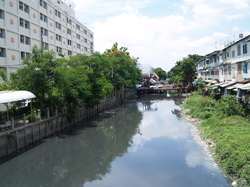
When operating well, EPA found ponds remove
- TSS - 67%
- Total Phosphate - 48%
- Total Nitrogen - 31%
- Nitrate - 24%
- Metals - 24.73%
Best Long term Control Strategies
- Add mixers to circulate the contents of the pond. This is the greatest way to improve pond conditions and maintain a stable balance between bacteria, algae and pollution removal. I am a personal fan of the Solar-Bee type mixers from (http://www.medoraco.com)
- Use bacteria additives when needed to remove pollutants such as petroleum (oil sheen) or following periods where loadings have increased or washout occurred. The bacteria can also enhance sludge removal when coupled with mixers. Aster Bio's AB-10 has been tested in various ponds to help with problem pollution degradation and algae control.
- Copper sulfate is effective for rapid algae control, but is limited in effectiveness when no mixers are present. It is a short-run solution to the problem at best.
- Dyes that prevent photosynthesis by algae. This solution creates is expensive and makes the water look very unnatural. However, for very shallow, small ponds near a residence it can be a solution.

 RSS Feed
RSS Feed